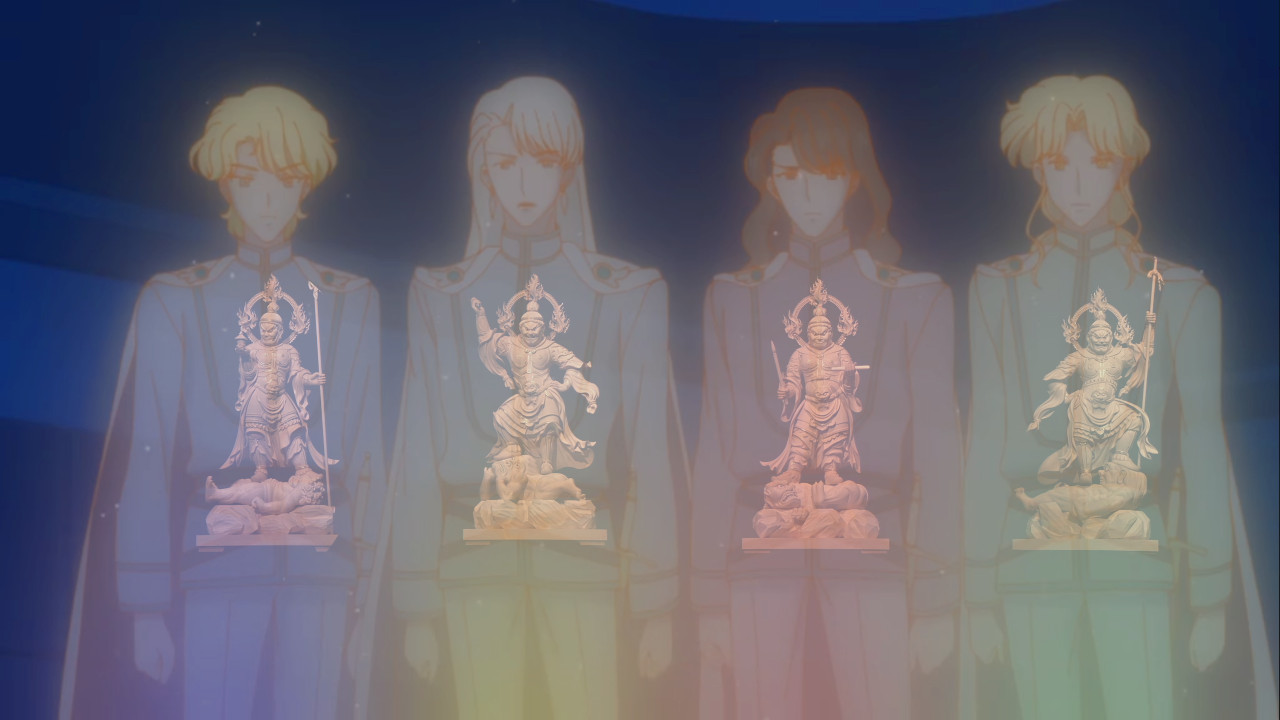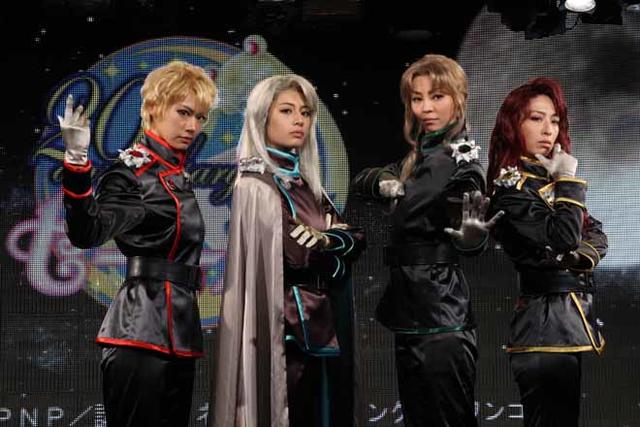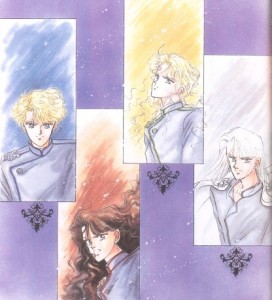What many people don’t realize at first glance is that Ms. Takeuchi is not only a talented manga artist, but has an impressive background in the sciences.1 From joining the astronomy club in her high school days to majoring in chemistry (and later becoming a licensed pharmacist) in university, she had a very diverse base of information to draw upon when creating the Sailor Moon universe. The Four Kings (Shi Ten’Ou; 四天王) of the Dark Kingdom – Jadeite, Nephrite, Zoisite, and Kunzite – are no different.
As with the names of each of the Sailor Soldiers (and many of the other characters in the series), the names of the Kings are no accident and have a deeper meaning behind them. Before we can get into the importance of their names themselves, though, we’ll need to first discuss where the concept of the “Four Kings” comes from in the first place. The “Four Heavenly Kings” comes from a Buddhist belief in four gods governing over each of the four cardinal directions: North, South, East, and West.2 Though the names of each of these kings (and the group themselves) differs by country, it should be safe to keep the scope of this conversation limited to its background in Japan due to this being where the series takes place.
The Buddhist Four Heavenly Kings are:
- Tamon-ten (多聞天), The King Who Hears All
He is known as the leader of the Four Kings and governs over the North. He is most typically associated with the colors yellow and green. - Zouchou-ten (増長天), The King Who Causes Growth
He is known for causing the growth of roots and plants and governs over the South. He is most typically associated with the color blue. - Jikoku-ten (持国天 or 治国天), The King Who Upholds the Realm
He is known for being protective and compassionate and governs over the East. He is most typically associated with the color white. - Koumoku-ten (広目天), The King Who Sees All
He is known for watching from above and on the lookout for non-believers in Buddhism and governs over the West. He is most typically associated with red.
The Sailor Moon Four Kings are:
- Jadeite
Associated with the color blue in the manga and red in the anime. He serves as commander over the Dark Kingdom’s Far-Eastern armies (which include Japan and East Asia). Jadeite is described as approximately 18 years old in the manga. - Nephrite
Associated with the color red in the manga and yellow in the anime. He serves as commander over the Dark Kingdom’s North American armies. Nephrite is described as approximately 19 years old in the manga. - Zoisite
Associated with the color green in both the manga and the anime. He serves as commander over the Dark Kingdom’s European armies. Zoisite is described as approximately 16-17 years old in the manga - Kunzite
Associated with the color white in both the manga and the anime. He serves as commander over the Dark Kingdom’s Middle-Eastern armies. Kunzite is described as approximately 25-26 years old.
Right away, you’ll notice that there’s an inconsistency in the colors between the manga and the anime. As this inconsistency was fixed in the live action series as well as in the new animated series, Crystal, it’s safe to assume that the manga colors are correct. More than likely, this is simply attributed to the anime coming out before a color picture of the Four Kings was released.3
Going purely off the colors, that would mean that we have: Jadeite = Zouchou-ten; Nephrite = Koumoku-ten; Zoisite = Tamon-ten; and Kunzite = Jikoku-ten. But what about the directions? Well, those mostly match up as well, with Nephrite/Koumoku-ten being the king of North America in the Western world, Zoisite/Tamon-ten being the king of Europe up in the North, Kunzite/Jikoku-ten being the king of the Middle-East. Jadeite/Zouchou-ten doesn’t fit this mold though, which we can only assume is due to needing to fit in a commander over Japan and having no good candidates for South.
One final and interesting tidbit about the Four Kings is how their names may tie into the armies they command. Though stones are found in many locations around the world the stones each of the Kings are named for occur in the regions they are in charge of: jadeite has been found in Itoigawa, Japan; nephrite is found on the Pacific and Atlantic coasts of North America; zoisite is found in Norway, Switzerland, and Austria; and kunzite can be found in Afghanistan and Pakistan.
References:
- See Naoko Takeuchi (Wikipedia) ↩
- See Four Heavenly King (Wikipedia) ↩
- The first time a picture of the Four Kings appeared in color was in Act 13, released in the March 1993 edition of Nakayoshi. Interestingly enough, though, the long-running Sailor Moon musicals continue to go with the traditional anime colors ↩




Very interesting! I like the Shitennou and wished they had a bigger more extended role over the series…
So interesting! This reminds me of the “Sailor Moon: Another Story” game when you go in search for the stones of the Shitennou and are sent to Switzerland, Canada, Nepal and Turkey.